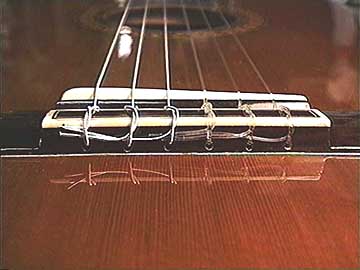Then loop under again:
Keep the twisted loops together as you wind up the string:
This seems like a three-handed job at first, but not it's really difficult once you've done it a couple of times.
By the way, it's perfectly legal to treat the wound bass strings and the unwound trebles the same. Then, you'd make two loops at each end, even on the basses.
Here's the result of putting on the first and sixth:
I've made sure that the strings wind toward the outside of the rollers, making room for the middle strings. If you watch how the strings wind onto the rollers, you can guide them so they don't rub on the edges of the peghead or on each other.
Nylon strings, especially the trebles are incredibly stretchy. For the first day, it will seem as though you'll never get them in tune. They'll stabilize by the next day.
Some people try to pre-stretch the strings in an effort to make them stay in tune better right away. Don't do it. Stretching the strings (beyond normal tuning to pitch) will cause them to develop thin areas, changing the distribution of mass. Uneven strings do not play in tune!
Most of the intonation problems on classical guitars are due to uneven strings. If you have one string that seems suddenly out of tune, it probably is. Cheap strings tend to be uneven at the outset. There are lots of different classical strings on the market, and they all perform differently. It pays to experiment to find the string that sounds best to you.
Just as a parting shot, take a look at this bridge:

Some tradtionalists like to tuck the loose end of the string each succesive string as they tie it on the bridge. It makes for a very tidy job.